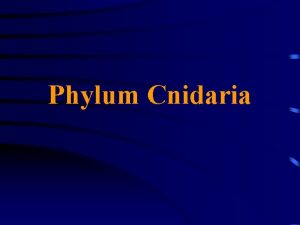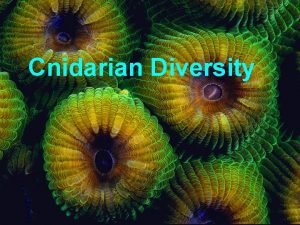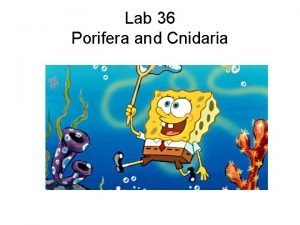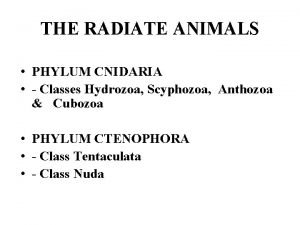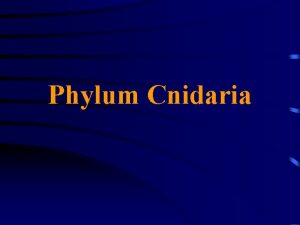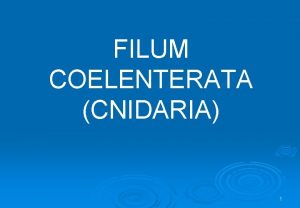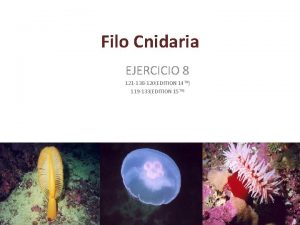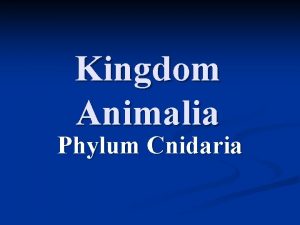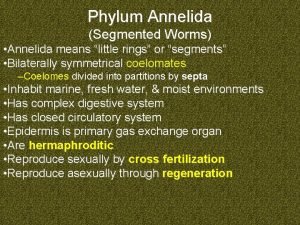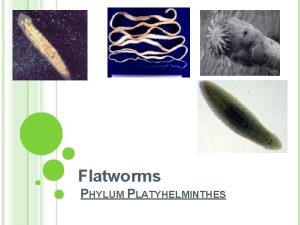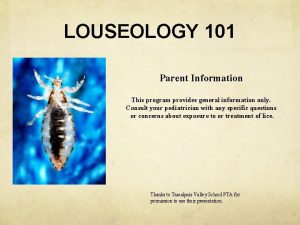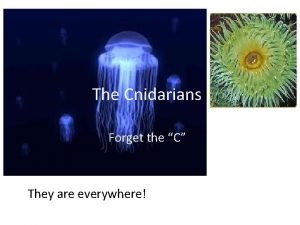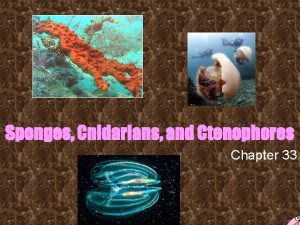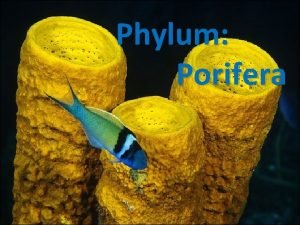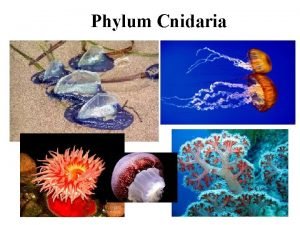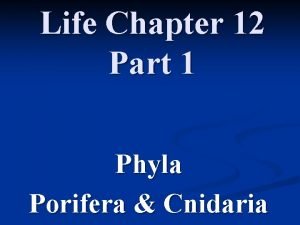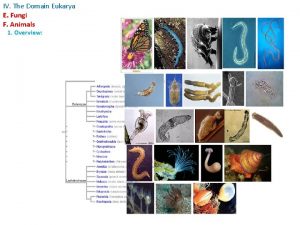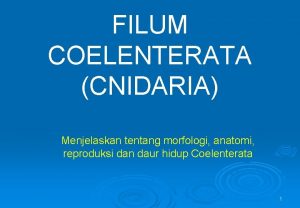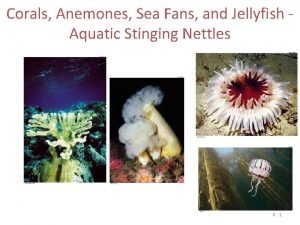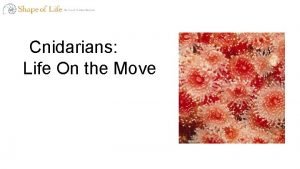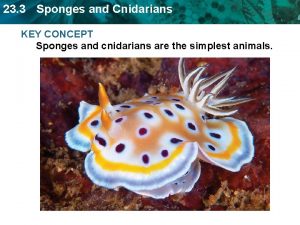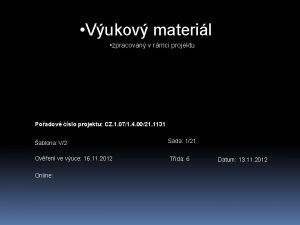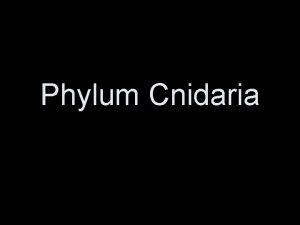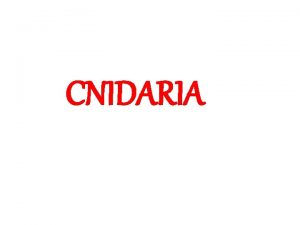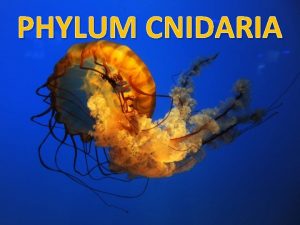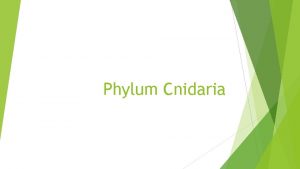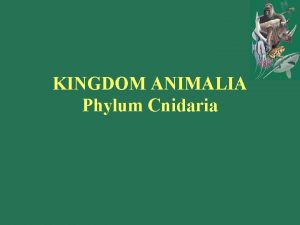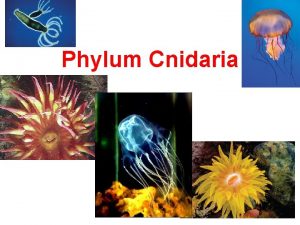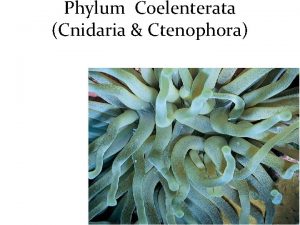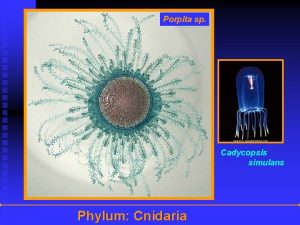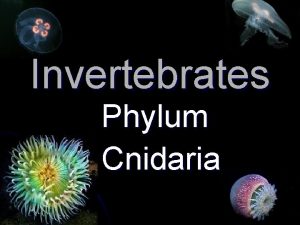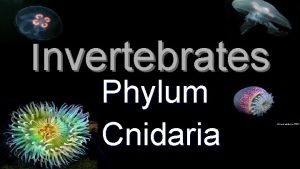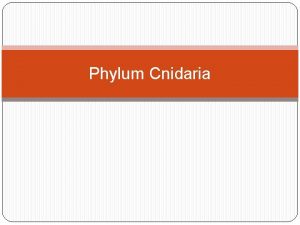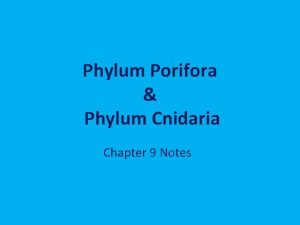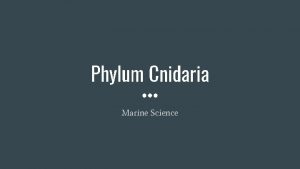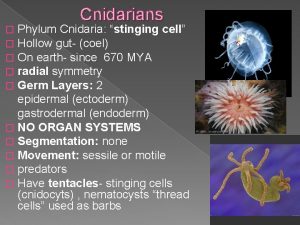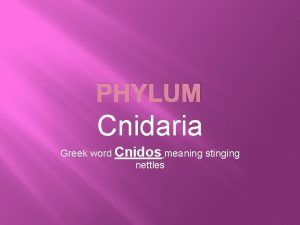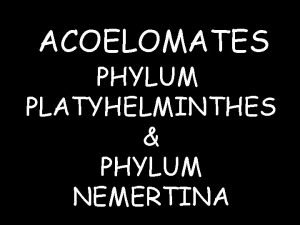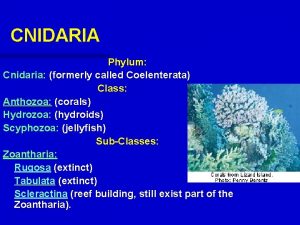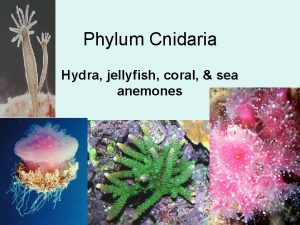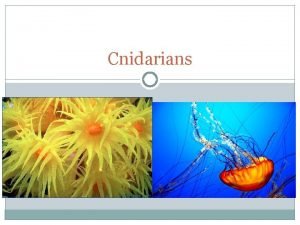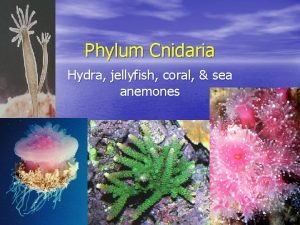Phylum Cnidaria General Information Cnidaria means a stinging







































- Slides: 39

Phylum Cnidaria

General Information: • Cnidaria means ‘a stinging thread’ • Examples: sea anemones, corals, jellyfish, freshwater Hydra, and the Portuguese man of war • Habitat: marine and fresh water

Soft Coral Sea Anemone, Clover Point, Victoria B. C.

Portuguese Man Of War Brain Coral


Characteristics: Characteristics • All cnidarians have a basic radial symmetry and possess only 2 layers of living tissues. • 2 tissue layers: ectoderm and endoderm • Contain a mesoglea • Some possess an exoskeleton (for protection) made up of Ca. CO 3 (e. g. corals)


Characteristics • Have 2 body forms: a. Polyp (sessile) – e. g. hydra, coral, or sea anemone b. Medusa (free swimming) – bell shaped – e. g. jellyfish

• Some cnidarians contain only one body shape during their life cycle, while others contain both during their life cycle • When a cnidarian exhibits the 2 body forms in its life cycle, it is called polymorphism (‘many shapes’) • The evolution of a primitive nervous system sets these organisms apart from the sponges – called a nerve net • They contain nematocysts found on the tentacles used for capturing prey and for protection




• Mesoglea is sandwiched between ectoderm and endoderm • There amoebocytes in the mesoglea of cnidarians, much like in sponges • Cnidarians possess a simple digestive system – the gastrovascular cavity – where digestion and circulation of nutrients occur http: //shapeoflife. org/video/cnidarians life move



Sea Anemones – Class Anthozoa: • • No medusa stage They are all marine Polyp body form exclusively Reproduce asexually through longitudinal or transverse fission (like binary fission, but on a much larger scale) • Are primarily carnivorous – capture food using nematocyst studded tentacles and transfer it to a central mouth opening • There around 6000 species of sea anemones


Coral – Class Anthozoa • Colonial form of Class Anthozoa • Can have soft and hard corals • Hard corals secrete external Ca. CO 3 skeletons and are called ‘stony corals’ • Stony corals make up coral reefs (not all make reefs though) • Coral add about 10 kg of additional Ca. CO 3 per m 2 of reef yearly • Soft corals do not have hard external skeletons


The Anatomy of A Coral • Many corals have symbiotic green algae called zooxanthellae living in their polyps • Warmer ocean temperatures can cause these algae to die, resulting in a phenomenon known as “coral bleaching”


Corals are an important part of BC marine ecosystems! • In BC, deep water corals such as the red tree or “Gorgonian coral” provide shelter for juvenile rockfish such as the yelloweye rockfish or sharpchin rockfish

Jelly Fish – Class Scyphozoa • Only a few hundred species – nearly all are marine • The body is in the form of an inverted cup, with nematocyst studded tentacles extending downward from the cup. • Some jellyfish have symbiotic unicellular algae that give them nutrients • The life cycle of jelly fish involves the two different body forms: polyp and medusa

A Typical Jellyfish Life Cycle




A Typical Cnidarian – Hydra Class Hydrozoa Structure: • Polyp body form Locomotion: • Sessile; however, some can somersault and glide along while secreting mucus

Ingestion, Digestion, Elimination • Food is captured by nematocysts in the tentacles by stinging or stunning prey • Tentacles push food through mouth into gastrovascular cavity • Flagella line the endoderm layer and create a current • The endoderm cells secrete enzymes to break down food • Food is taken into cells and nutrients are circulated by amoeboid cells • Wastes are eliminated out through the mouth • https: //www. youtube. com/watch? v=Kukv 0 At. IVd

Respiration • O 2 enters the cells by diffusion • CO 2 leaves the cells by diffusion

Nervous System • Have a nerve net within the mesoglea • When stimulated, the nerve net will respond by contracting / relaxing the muscles • Have sensory cells that are sensitive to touch, light, chemicals, and balance


Muscular System • Longitudinal and circular muscle fibres are found in the endo / ectoderm layers

Excretion • Nitrogenous wastes leave the cells by diffusion • Solid wastes enter the gastrovasuclar cavity and leave via the mouth (Elimination)

Reproductive System A. Asexual • Budding (bud breaks away) • Regeneration (re growth of missing parts) A Hydra Budding

Reproductive System B. Sexual • Some are hermaphrodites • Ovaries and testes grow on the side of adults • Ovary produces an egg and remains attached to the adult • Testes produce the sperm which swim to the egg, resulting in a zygote • Zygote develops into a ball of cells called the blastula, which develops into a ciliated larva called a planula, planula which can swim to another location, settle, and develop into a polyp adult


Evolutionary Significance • Cnidarians are the first animals to have organized true cell tissues • They are therefore the first true multicellular organisms to appear • They are the first organisms to have muscle tissue and nervous tissue • Cnidarians, having radial symmetry are thought to share a common ancestor with all other multicellular animals

 Phylum cnidaria general characteristics
Phylum cnidaria general characteristics Stinging cells
Stinging cells Stinging trichomes
Stinging trichomes Stinging limu
Stinging limu Is hydra a porifera
Is hydra a porifera Life cycle of obelia
Life cycle of obelia Cnidaria digestive tract
Cnidaria digestive tract Cnidocytes jellyfish
Cnidocytes jellyfish Characteristics of phylum cnidaria
Characteristics of phylum cnidaria Chironex fleckeri classification
Chironex fleckeri classification Filo platelmintos
Filo platelmintos Hydra jellyfish sea anemone sea urchin
Hydra jellyfish sea anemone sea urchin Cnidaria characteristics
Cnidaria characteristics This phylum name means “little rings”
This phylum name means “little rings” Which phylum means jointed foot
Which phylum means jointed foot Annelus means small ring
Annelus means small ring Aplacophora characteristics
Aplacophora characteristics Phylum platyhelminthes characteristics
Phylum platyhelminthes characteristics Poly means many and gon means
Poly means many and gon means Meta means morphe means
Meta means morphe means Meta means in metamorphism
Meta means in metamorphism Meaning of biodiversity conservation
Meaning of biodiversity conservation Bio means life logy means
Bio means life logy means Diferencia entre gran plano general y plano general
Diferencia entre gran plano general y plano general Where did general lee surrender to general grant?
Where did general lee surrender to general grant? Sending and receiving information is called
Sending and receiving information is called Humid subtropical climate
Humid subtropical climate Scotland general information
Scotland general information Provides general information
Provides general information Cnidaria tissue layers
Cnidaria tissue layers Section 33-2 review cnidaria and ctenophora
Section 33-2 review cnidaria and ctenophora Origin of the word
Origin of the word Cnidarians
Cnidarians Symmetry of sponge
Symmetry of sponge Cnidaria domain
Cnidaria domain Reproduksi coelenterata
Reproduksi coelenterata Cnidaria characteristic
Cnidaria characteristic Life on the move cnidarians answers
Life on the move cnidarians answers Sponges concept map
Sponges concept map Cnidaria symmetry
Cnidaria symmetry
